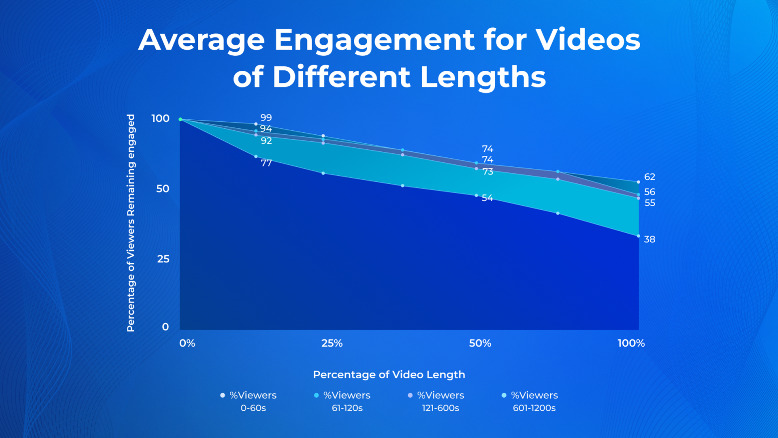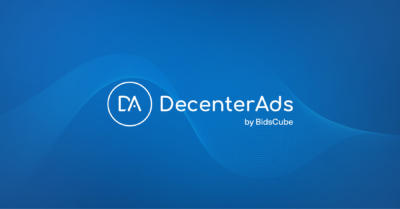Once Again, About Video Completion Rate
Share
23 August 2023

We have previously touched upon the topics of video completion rate and defined what the VCR is. In this article, we have reviewed projections indicating the dominance of video ads in programmatic ad spend by 2022. Fueled by platforms like TikTok and Reels, it becomes increasingly crucial to increase the presence of video ads in campaigns and comprehend influential video ad metrics, such as VCR. However, in response to numerous requests from our partners, we now aim to delve deeper into this matter, examining crucial indicators associated with this metric.
How Does VCR Help Advertisers?
CTV audiences reportedly achieve an impressive 97% view-through rate. Advertisers turn to Video Completion Rate as a vital metric for multiple compelling reasons.
Firstly, VCR provides valuable insights into viewer engagement with video ads. Advertisers can gauge the effectiveness of their messaging and creative content by measuring the percentage of users who watch a video ad to completion.
Secondly, VCR helps advertisers optimize their campaigns and make data-driven decisions. By analyzing VCR data, advertisers can identify which videos perform best and adjust their strategies accordingly. They can refine targeting, messaging, and placement to enhance viewer engagement and increase the likelihood of video completion.
The VCR formula can be customized and tailored to suit each business’s specific needs and goals. Advertisers can define a “completed view” based on campaign objectives and industry standards. This individualized approach ensures that the VCR metric accurately reflects the business’s unique requirements and provides actionable insights.
How to Calculate the VCR?
To calculate the indicator, you can use a simple video completion rate formula:
VCR = (View-Throughs x 100) ÷ Impressions
To gather the necessary data, you will need two key numbers. The first is the count of view-throughs, representing how often the video was watched from start to finish without skipping any parts. The second number is the total impressions, which refers to the number of times the video was played. Usually, you can find this information in the analytics program’s dashboard or reporting section.
For example, let’s say you have 1000 view-throughs and 5,000 impressions. The calculation would be:
VCR = (1000 x 100) ÷ 5,000 = 20%
This means that your Video Completion Rate is 20%.
The Impact of Length of Video on VCR
Generally, shorter videos tend to have good VCR compared to longer videos. This is because shorter videos have a higher chance of holding viewers’ attention and keeping them engaged until the end. For most videos, the optimal duration falls within the range of one to two minutes. This timeframe provides ample opportunity to convey your story effectively without risking boredom or overwhelming your audience. However, the optimal video length can vary across platforms based on user behavior and platform-specific dynamics.

Global Analysis of CTV Ad Performance Metrics: VCR Trends Across Ad Lengths in 2022
Shorter videos, typically under 60 seconds, tend to be more successful on social media platforms such as Facebook, Instagram, and Twitter. Users prefer quick and easily digestible content that aligns with their browsing habits.
YouTube provides greater flexibility regarding video length, as the ideal duration can vary based on content and audience. YouTube viewers are generally more inclined to engage with longer-form content and invest their time accordingly.
Streaming services like Hulu, Twitch, and Netflix prioritize long-form content like TV shows, movies, and live streams. The duration of videos can vary significantly, spanning from a few minutes to several hours, depending on the specific platform and content type. Audiences on these platforms are often highly engaged and more willing to dedicate time to immersive video experiences.

Average Engagement for Videos of Different Lengths
The Impact of Content Quality on VCR
The content quality significantly impacts the VCR metric. Engaging and relevant content increases the likelihood of viewers staying engaged until the end of the video.
By analyzing video metrics with VCR, advertisers can understand the quality and effectiveness of their campaigns. The metrics also worth relying on when calculating and analyzing VCR are as follows:
- VTR measures the percentage of viewers who watched a video ad to a specific threshold of its total duration. A high VTR indicates strong viewer engagement.
- eCPC calculates the cost incurred per click on a video ad. It helps determine the efficiency and cost-effectiveness of the campaign. This metric represents the number of times viewers watched the video ad to completion. A higher number of videos completes higher engagement and interest from viewers.
- Video starts refer to the total number of times the video ad was initiated or played. Comparing video completes to video starts can provide insights into viewer drop-off rates and retention.
- CTR calculates the proportion of viewers who click on a video ad after watching it. A higher CTR indicates that the ad resonated well with viewers and prompted them to take further action.
- CPM represents the cost incurred for every one thousand video ad views. It helps evaluate the cost efficiency of reaching a specific audience size.
How to Track View-Through Rates?
We suggest tracking view-through rates (VTRs) at various video durations throughout your campaign. For instance, if you have a 45-second video asset, you can focus on measuring VTRs for the 30-second mark as the primary key performance indicator (KPI) while also considering VTRs for 100% completed views (commonly referred to as Video Completion Rate or VCR).
Ad-server or DSP reporting tools typically present video views in quartiles, such as 25%, 50%, 75%, and 100% viewed. This alternative approach showcases quartile-specific view-through rates (VTRs) instead of time-specific ones. Analyzing these quartile-specific rates allows you to identify drop-off points and provide valuable insights to your creative team for enhancing future videos. DecenterAds DSP offers a convenient Monitoring tool option, which generates request reports and displays the levels of all requested metrics, including VCR and the number of impressions, simplifying tracking and analysis.
How to Enhance Video Completion Rate?
Here are a few short tips to maximize your video completion rate.
- Consider keeping your content under 20 seconds and breaking down lengthy information into bite-sized videos.
- Focus on creating relevant and engaging content. By segmenting and targeting your target audience, you can develop advertising videos that resonate with your ideal consumers. Understanding their demographics and preferences lets you customize your message, making your videos more engaging and shareable.
- Familiarize yourself with different platforms and optimize your content based on their unique features. Each social media platform has its strengths, and adapting your calls to action accordingly can make them more effective and engaging.
- You should establish a channel by attracting genuinely interested users. Factors such as video ad placements, player size, and buffering time significantly influence viewability, so it’s essential to consider them to boost your completion rate.
- Consider the subtle elements that captivate users and draw them into interacting with your content. Ensure your thumbnails, closed captioning, and video descriptions are carefully crafted to capture attention and accurately convey the video’s content. When viewers find what they were expecting, they are more likely to stay engaged and less inclined to click away.
How to Boost the Visibility of Your Brand?
The video completion rate (VCR) indicates the percentage of viewers who watched your ads from start to finish. A low VCR suggests a lack of interest or ineffective engagement. A high cost-per-completed-view (CPCV) may not always be negative, as it means targeting the right users, while a low CPCV indicates strong ad performance. However, prioritizing user experience is crucial to avoid annoying viewers. To reduce CPCV, consider targeting a broader audience, improving the quality and length of your video ads, rotating videos during a campaign, and setting frequency caps to define the number of times a user sees a particular video.
To Sum Up
Understanding and optimizing the video completion rate is crucial for advertisers. VCR provides valuable insights into viewer engagement and helps make data-driven decisions to optimize campaigns. Calculating VCR involves determining the count of view-throughs and total impressions. Shorter videos generally have higher VCRs, but optimal length can vary across platforms. Content quality plays a significant role in VCR, as engaging and relevant content increases viewer engagement. Tracking view-through rates (VTRs) at different durations and quartiles can help identify drop-off points and enhance future videos. To improve VCR, create shorter and more engaging content, target the right audience, adapt to platform features, optimize viewability, and pay attention to compelling elements like thumbnails and captions. Prioritizing user experience and considering CPCV, targeting, video quality, rotation, and frequency caps can boost brand visibility.
Stay up to date with our company news

16 May 2024
We’re thrilled to introduce the latest addition to our ecosystem: the all-new DPS features! This is a significant leap in our evolution and a testament to our commitment to continuous improvement. Over a decade ago, DecenterAds set out on a mission as a self-service platform, providing Ad Tech market players […]

06 May 2024
Your inquiry met with our response, and in this article, we will delve into the Data Protection Laws of the APAC region. In August 2023, India passed the Digital Personal Data Protection Act (DPDP), a significant law for data protection globally. This comes as part of a broader trend in […]

21 April 2024
APAC video streaming has not only revolutionized the region’s film industry but also transformed consumer behavior. With the emergence of numerous platforms, viewers can now access content on any device, from mobile phones to large TV screens. This long-anticipated shift signifies an impressive change in how consumers engage with content, […]

